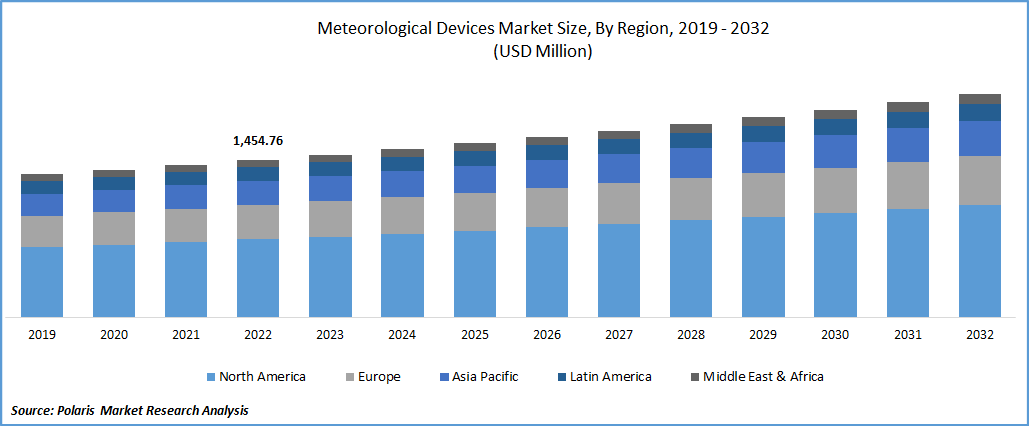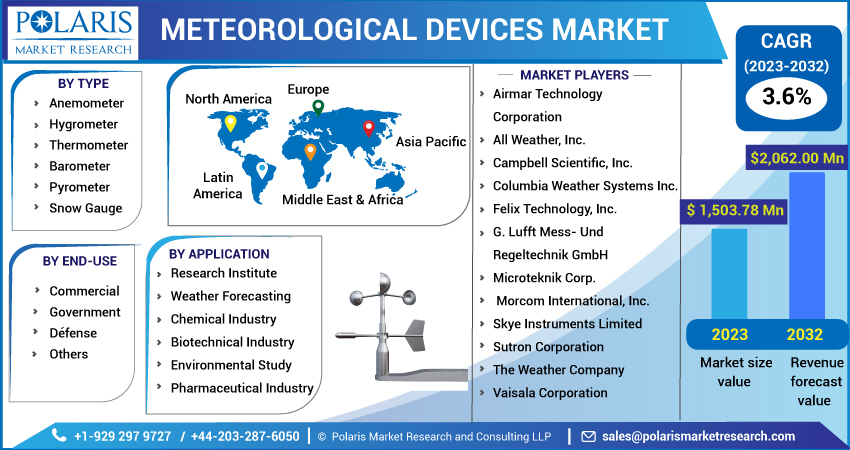
Meteorological Devices Market Share, Size, Trends, Industry Analysis Report, By Type (Anemometer, Hygrometer, Thermometer, Barometer, Pyrometer, Snow Gauge, and Others); By Application; By End-Use; By Region; Segment Forecast, 2023-2032
- Published Date:Jun-2023
- Pages: 118
- Format: PDF
- Report ID: PM3318
- Base Year: 2022
- Historical Data: 2019-2021
Report Outlook
The global meteorological devices market was valued at USD 1,454.76 million in 2022 and is expected to grow at a CAGR of 3.6% during the forecast period. Instruments or sensors used in meteorology assist in determining the condition of the atmosphere at a particular time. These tools are made to work in every climate zone under normal circumstances and are used to measure and record meteorological element values. The equipment works consistently, gives accurate readings over a broad range of temperatures, and is unaffected by strong winds and dust. Meteorological instruments are used for measurement and analytical applications to comprehend the pattern of weather conditions, related hazards and warnings, and warning systems and broadcasting for numerous industries, commercial, governmental, and defense purposes. Other industrial uses for these gadgets include cleanroom settings and production in regulated environments.

To Understand More About this Research: Request a Free Sample Report
Weather components such as wind humidity, pressure, cloudiness, and temperature must be accurate for the aviation, fishing, agricultural, and defense industries. The increasing reliance of large companies on climatic conditions is significantly boosting the global market for meteorological equipment. As a result of unpredictable weather hurting many companies, meteorological equipment is being adopted more frequently. This forces businesses to implement these systems, enhancing their operational efficiency, and is a key factor in expanding the meteorological equipment market.
Weather forecasting is the area of meteorology. Air pressure, temperature, mass flow, water vapor, interactions, and fluctuations characterize and measure Earth's atmosphere. Meteorological instruments gather real-time weather data, including hygrometers, barometers, anemometers, and others. End-use businesses use this data, including the chemical industry, research institutions, aerospace & defense sectors, and weather forecasting stations.
The market is expanding due to the rising demand for temperature measuring tools, such as pyrometers, resistor thermometers, and temperature sensors, for industrial applications. In March 2021, A new kind of thermometer that can swiftly monitor the temperature with excellent accuracy in quantum calculations was created by Swedish researchers. For instance, In September 2021, AMETEK Land introduced SPOT AL, a new temperature measurement for use in its applications for processing aluminum. The SPOT AL series' capabilities for operators in the aluminum industry will be enhanced by adding liquid aluminum temperature and low-temperature measurements. As a result, the market is expanding due to the growing need for improved solutions. However, the lack of a measure of climate risk by small and medium-sized enterprises in developing nations is a significant problem that might impede the market's expansion.
The market suffered from decreased demand, production halts, tangled supply chains, delayed deliveries of vital device components, and contracts put on hold during pandemic. In addition, the COVID-19 pandemic has affected companies that depend on meteorological devices. The dynamics of this industry have changed due to the decline in demand. The shutdown significantly impacted the meteorological sensor production, which caused a halt. COVID-19 affected countries' spending on environmental protection and moved it to the healthcare industry. European and Asia-Pacific nations announced a decrease in meteorological expenditure due to the COVID-19 problem.

For Specific Research Requirements, Speak With a Research Analyst
Industry Dynamics
Growth Drivers
The requirement for precise real-time data from next-generation sensors and security precautions has fueled the expansion of meteorological equipment and software manufacturers. The Federal Aviation Administration's (FAA) description of escalating accidents and safety standards as the main drivers for real-time data management software implementation. Tracking real-time data helps helicopter and airplane pilots make the necessary judgments while in flight. Also, the flight management software placed in the helicopter provides details about the hardware and software systems.
In addition, the development of the meteorological devices market is being fueled by the introduction of cutting-edge technologies, including wireless communication, next-generation workstation, forecasting structures, communications infrastructure, and digital database forecasting. Automated forecasting techniques are also expected to improve weather stations' overall performance. Artificial intelligence (AI) and the Internet of Things (IoT) are becoming more useful in aviation and helicopter. Thus, the market expansion is driven by the aerospace industry's increasing adoption of IoT-based devices and cutting-edge meteorological software applications.
Report Segmentation
The market is primarily segmented based on type, application, end-use, and region.
|
By Type |
By Application |
By End-Use |
By Region |
|
|
|
|
For Specific Research Requirements: Request for Customized Report
The Commercial Segment is Expected to Witness the Fastest Growth During the Forecast Period
Throughout the projected period, the commercial segment is anticipated to grow the fastest and have the highest CAGR. The rapid uptake of numerous commercial applications will fuel the industry's expansion. Increasing investments in meteorological research and forecasting for various environmental risk forecasts are predicted to propel market expansion. Over the forecast period, the government & defense category held the greatest market share. By allocating funds from the federal budget to their meteorological agencies, governments across the globe have invested heavily in weather forecasting & environmental research.
The Hygrometer Segment Industry Accounted for the Highest Market Share in 2022
The hygrometer segment accounted for the highest market share in 2022. The expansion of the segmented market is anticipated to be driven by industrial applications of relative humidity monitoring in the pharmaceutical and biotechnology industries during the forecast period. Throughout the projection period, it is expected that the introduction of small Internet of Things (IoT) devices and the increasing acceptance rate of industrial portable measuring equipment will propel market expansion.
Weather Forecasting Segment Garnered the Largest Share in 2022
The weather forecasting segment held the largest revenue share. Also, the market would rise due to the growing adoption of automated nowcasting systems. The second-largest sector throughout the forecast period was predicted to be environmental study. International meteorological organizations are concentrating on funding ecological research for the next ten years despite the growing concerns climate change poses. These environmental studies are used to develop national or region policies, build climate-resilient homes, and develop industrial and commercial production and utility practices. It is projected that these reasons will fuel market expansion.
The Demand in North America is Expected to Witness Significant Growth During Projected Period
The key reasons for this expansion are the rising adoption and high precision of cutting-edge technology and the rising demand from numerous end-use sectors, including aerospace. Due to significant manufacturers operating there, North America held the greatest global market share. One of the main factors propelling the market is the widespread deployment of meteorological equipment in the airline and commercial industries.
Asia Pacific is anticipated to develop at the highest CAGR. Throughout the projected period, the market is expected to be driven by increased investments in meteorology and soaring regional demand for weather forecasting. Agriculture is a significant source of income for nations like China and India, which fuels the desire for precise systems to predict climate conditions. Due to the implementation of courageous climate change decisions, the demand has gained momentum. The South African Weather Service (SAWS) aims to become a Weather and Climate Center of Excellence by providing creative solutions to promote long-term growth and economic success in a weather-smart region.
Competitive Insight
Some of the major players operating in the global meteorological devices market include Airmar Technology Corporation, All Weather, Campbell Scientific, Columbia Weather Systems, Felix Technology, G. Lufft Mess- Und, Microteknik Corp., Morcom International, Skye Instruments, Sutron Corporation, Weather Company, & Vaisala Corporation.
Recent Developments
- In April 2022, AccuWeather and Digital Turbine established a multiyear agreement that will utilize the whole ad stack of Digital Turbine in three aspects: audience development, in-app monetizing, and app distribution. For native on-device inventories, Digital Turbine will be the authorized global distributor of AccuWeather apps. Also, AccuWeather will be a favored source for editorial advertising inside Digital Turbine's Content Media Solutions for its meteorological and weather-related information library.
Meteorological Devices Market Report Scope
|
Report Attributes |
Details |
|
Market size value in 2023 |
USD 1,503.78 million |
|
Revenue forecast in 2032 |
USD 2,062.00 million |
|
CAGR |
3.6% from 2023– 2032 |
|
Base year |
2022 |
|
Historical data |
2019– 2021 |
|
Forecast period |
2023– 2032 |
|
Quantitative units |
Revenue in USD million and CAGR from 2023 to 2032 |
|
Segments Covered |
By Type, By Application, By End-Use, By Region |
|
Regional scope |
North America, Europe, Asia Pacific, Latin America, Middle East & Africa |
|
Key Companies |
Airmar Technology Corporation, All Weather, Inc., Campbell Scientific, Inc., Columbia Weather Systems Inc., Felix Technology, Inc., G. Lufft Mess- Und Regeltechnik GmbH, Microteknik Corp., Morcom International, Inc., Skye Instruments Limited, Sutron Corporation, The Weather Company, and Vaisala Corporation |
FAQ's
key companies in meteorological devices market are Airmar Technology Corporation, All Weather, Campbell Scientific, Columbia Weather Systems, Felix Technology, G. Lufft Mess- Und.
The global meteorological devices market expected to grow at a CAGR of 3.6% during the forecast period.
The meteorological devices market report covering key segments are type, application, end-use, and region.
key driving factors in meteorological devices market are requirement for precise real-time data from next-generation sensors and security precautions.
The global meteorological devices market size is expected to reach USD 2,062.00 million by 2032.
